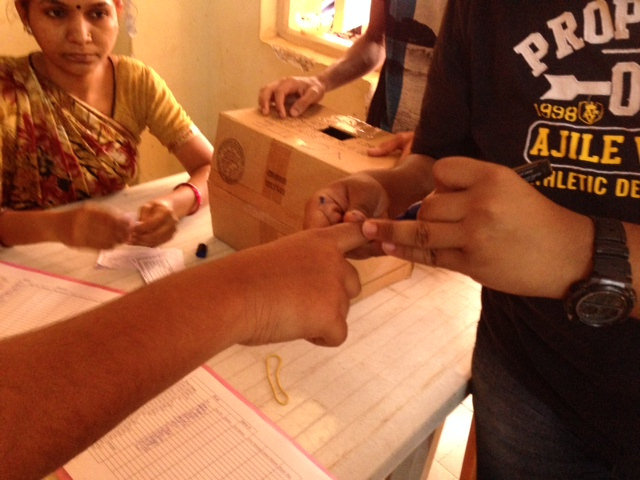The school welcomes involving students in shaping the day to day organization and the ‘organization’s rules’. In lessons, students regulary review their own learning, with the teacher and other students. Student views are taken into account when planning the curriculum.
Self-review validation scores by Adhyayan Assessors across 68 schools tell us a story: schools aspiring to global standards are likely to include student needs and interests in their curriculum.
Shishuvan School, Matunga, Mumbai was rated “Outstanding” on this Key Statement. The school has a robust student leadership structure.
What makes the Shishuvan leadership structure so special? To start with, the structure is clearly defined with representation from all classes of the Middle and High School. The election process is democratic (To read more about the Shishuvan Election Process, read this post on the school blog.) Roles and functions of all ministers and speakers are enunciated with great deal and much thought has been put in to systems and processes.
Menaka Raman, Social Media and Online Content Lead at Adhyayan sat in on a meeting conducted by Middle School House Representatives. “Representatives voiced their concerns and issues confidently. Everyone was given a chance to share and students respectfully listened to one another. It was clear that students felt safe in this space .”
Former Shishuvan Prime MinsterPoojan Sanghvi details for Adhyayan about the Shishuvan Student Leadership Structure.
The Prime Ministers and Deputy Prime Minster are at the head of the student body and represent the school at seminars, meetings etc. The PMs conduct ministry meets and leadership training sessions with the ministers and deputy ministers who as a whole are known as the Cabinet Ministry.
The ministers are allocated portfolios with varied functions concerning the upkeep of the school.
· LAW & JUSTICE – Concerned with formulation of laws, rules and regulations and consequences.
· ENVIRONMENT- Concerned with hygiene and infrastructure at large.
· LABOUR – Mediate between students and educators on education, study workload etc.
· PARLIAMENTARY AFFAIRS – Concerned with planning, execution and documentation of parliamentary affairs.
· IT & COMMUNICATION – Concerned with interactive technology, communication systems and media
· CULTURAL – Concerned with the celebrations and raising awareness about different cultural and traditional practices from around the globe.
· Human Resource Development – Concerned with mediation, and overall welfare of students and teachers.
· SPORTS – Concerned with sports activities, sports day celebrations and all maatters regarding sports training.
· EXTERNAL AFFAIRS – Concerned with communication with other institutions and co-ordinating inter school activities. They are also in charge of taking visitors around the school and act as guides.
· HOME – Concerned with resources and supplies and to some extent the security and safety in the school premises.
Ministry Meets
Ministry meets are a space for ministers to take up new initiatives and formulate viable solutions for an already existing policy against which the majority of the student body and staff have concerns. Outcomes are discussed with and approved by the Prime Ministers and Deputy Prime Minister before being passed to the concerned authorities or presenting them to the council. The minister present and justify their policies and actions in front of the school council, periodically.
Leadership Training Sessions
House Representatives are trained and encouraged to turn into better future leader through the use of activities and discussions. The Speaker and Deputy Speaker are elected by all the members of the High School and House Representatives are elected by house members in each standard.
The concerns which come up in the house meet are forwarded by house representatives to the Speakers and Parliamentary Affairs Minister. These are then distributed to the various ministries according to their portfolios and functions in order to procure solutions or remedial actions. The outcomes are presented in parliament and are open to questions and suggestions by the members of the parliament. The deliberated upon solutions or remedial actions are then passed on to the concerned authorities for final approval and implementation.
INVOLVING STUDENTS IN PROBLEM SOLVING
A ‘Concern Box’ is put up in the corridor for students to share their concerns. Issues are rated on their level of importance and the size of members that they affect. Some are taken up in the council, some in circle time or mediation.
The concerns are then allocated to different classrooms and each member of the council selects one concern they feel they can contribute towards remedying and move to the classroom allocated to the concern.
A facilitator is chosen from among the students and the concern is tackled in an appropriate manner. A minimum of 3 outcomes or solutions are formulated. These are collated by the speakers and then displayed to the members of the council (students and staff). The members then vote for one solution and the solution with maximum votes is then passed on to the concerned authorities for final approval and implementation.
Such a structure enables students to
· Speak and put forth one’s own view in a confident manner
· Respect others’ views and opinions
· Deal with problems and unforeseen events
· Enhance managerial abilities
· Understand diplomatic ideologies
· Become better leaders
Harshil Vora, Shishuvan’s first Prime Minister looks back at his tenure
Students are always told what to do, when to do it and how to do it. Shishuvan defies that culture by creating a platform for students to make independent decisions regarding their education. As the school’s first Prime Minister I designed and facilitated leadership training sessions for the students. A leader must never push to get things done, but inspire others to do it. My message to all budding leaders “Don’t push, pull”!





